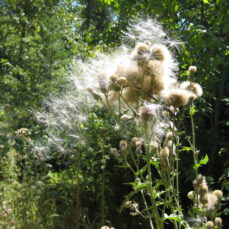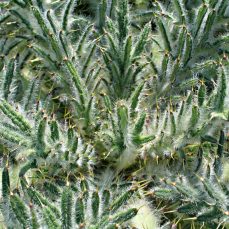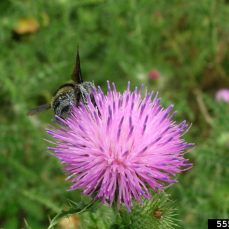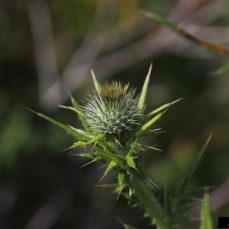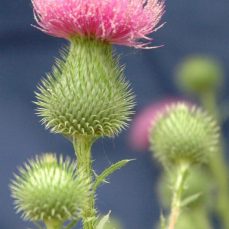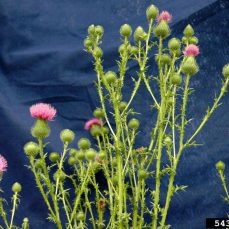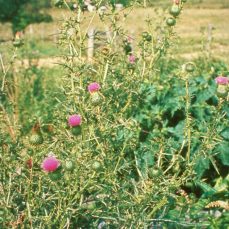
Photo credit: Bruce Ackley, The Ohio State University, Bugwood.org
Management Category
Squamish
Whistler
Pemberton
Vectors of Spread
ID Characteristics
Flowers: Deep pink-purple (sometimes white), gumdrop-shaped flowers at the end of each stem. Flower heads area about 4 – 5 cm wide, surrounded by spines that extend from the base all the way down the stems.
Stem: Growing up to 2 m tall, stems are stiff and spiny. Young plants from a rosette up to 1 m in diameter, while older plants are erect and branched.
Leaves: Deeply lobes leaves alternate on stems and branches, donning distinctive spiny tips. Rather dull in colour, the leaves are silvery green on top, with white hairs underneath.
Roots: With a main short, fleshy taproot in place, Bull Thistle grows many smaller, lateral roots to invade the surrounding area
Similar Species
Native
Wavy leaf thistle(Cirsium undulatum) is sometimes mistaken for bull thistle, but it is much shorter (0.3 – 1.2 m tall).

Photo credit: JW Stockert, Wikipedia
Invasive
Scotch thistle(Onopordum acanthium): One of the more distinguishing factors between Scotch and bull thistle are woolly stems and leaves – both of which are unique to Scotch thistle. If you have a keen enough eye, you might also notice the flowers on Scotch thistle are much larger, and more numerous, than bull thistle.

Photo credit: J. Leekie
Milk thistle (Silybum marianum) has distinctive marbling patterns on its leaves.

Photo credit: J. Leekie
Canada thistle (Cirsium arvense) is spineless, while bull thistle flower bases are covered in spines. In fact, bull thistle is the only thistle that has spines on the surface of the leaf.

Exotic
Plumeless thistle(Carduus acanthoides) has smaller flowers than bull thistle (about 2.5 cm in diameter). Bull thistle’s leaves are also hairier than plumeless thistle’s.

Photo credit: Joseph M. DiTomaso, University of California – Davis, Bugwood.org
Habitat and Origin
Introduced from Europe and Asia, bull thistle is believed to have made its way to North America as a seed contaminant.
Thriving in disturbed soils, this thorny plant can be found along clear-cuts, roadsides, and pastures. Resilient as it may be, bull thistle prefers rich, moist soils and does not tolerate shade. As a result, it doesn’t fare well in healthy, densely-canopied forests.
How it Spreads
- Bull thistle spreads through seeds, which germinate easily. In optimal conditions, mature bull thistle plants can produce 100 – 300 seeds per flower head, with one to more than 400 flower heads per plant.
- As a biennial or monocarpic perennial, individual bull thistle plants only set seed once before drying.
- If the seeds are buried 15 cm or deeper, they may remain viable in the soil for up to 3 years or more.
- Bull thistle seeds can spread more than 2 km per year in the wind, but usually land near the parent plant.
- Seeds are also spread by vehicles and equipment, or in contaminated soil.
Impacts
Ecological:
- Establishes quickly in disturbed areas, rapidly encroaching on native floral populations.
- Reduces biodiversity.
- Unpalatable to native wildlife.
- Once established, bull thistle is extremely difficult to eradicate due to its high seed production and sequential germination pattern.
Economic:
- Decreases forage value by contaminating hay bales.
- Limits livestock migration.
Prevent the Spread
Bull thistle is found in the Sea to Sky region and its distribution is beyond landscape-level control. When bull thistle is present at high-priority locations and negatively impacting them, their control is considered a high priority.
Otherwise, the goal is to prevent bull thistle from spreading to new (uninfested) areas, and to control it where possible to limit its impact on biodiversity.
Learn to identify bull thistle: use the images presented in this profile page to learn how to identify bull thistle
What to do if you spot it: You can report any bull thistle sighting by clicking here.
DO:
- Regularly monitor properties for weed infestations.
- Ensure soil and gravel are uncontaminated before transport.
- Ensure plants (particularly flowering heads and seeds) are bagged or covered to prevent spread during transport to designated disposal sites (e.g., landfill).
DO NOT:
- Do not plant bull thistle in a garden, no matter how well-contained its enclosure may seem.
- Do not move soil that has been contaminated with bull thistle.
- Do not compost!
Control
Mechanical
- Hand-pulling (while wearing gloves to protect yourself against the plant’s prickly spines) is effective for small infestations.
- Mowing before seed set is also an effective control method against bull thistle, since the plant dies off after setting seed.
- However, note that since plants mature and set seed at varying rates, repeated mowing throughout the season is recommended.
- Since bull thistle only reproduces by seed, control measures that sever the root below the soil surface are generally viewed as effective.
Chemical
- Aminopyralid, clopyralid, dicamba, glyphosate, triclopyr, chlorsulfuron, imazapyr, metsulfuron and 2,4-D have proven effective for bull thistle control.
- Picloram has also shown positive results, however it is not suitable for wet, coastal soils.
- Herbicides are most effective when used during the plant’s rosette stage or after mowing.
- The use of a surfactant is recommended, due to the hairy leaf surface.
- We recommend that any herbicide application is carried out by a person holding a valid BC Pesticide Applicator Certificate. Before selecting and applying herbicides, you must review and follow herbicide labels and application rates; municipal, regional, provincial and federal laws and regulations; species-specific treatment recommendations, and site-specific goals and objectives.
Biological
- A seed weevil, Larinus planus, has been released in the Sea to Sky to feed exclusively on invasive thistles.
- Most animals do not care for the bitter taste of Bull Thistle and will not consume it.
Integrated Control
- A combination of prevention and various control methods holds the highest success rate for bull thistle management and control.
- Reducing disturbances and reseeding are critical to preventing the plant’s return after treatment.
- Chemical control methods must be avoided if biocontrol agents have been released.
Sea to Sky Distribution
Bull Thistle Factsheet
Having trouble viewing the factsheet? Don’t worry, all the information is included on this page. You can also contact us with any questions.
Additional Resources
References
- Electronic Atlas of the Flora of BC, Cirsium vulgare
- Invasive Species Compendium (CABI), Cirsium vulgare
- Invasive Species Council of BC, Canada Thistle TIPS Factsheet
- Invasive Species Council of BC, Field Guide to Noxious and Other Selected Invasive Plants of British Columbia
- Invasive Species Council of BC, Scotch Thistle
- King County, Bull Thistle Identification and Control
- King County Noxious Weed Control Program, Best Management Practices for Bull Thistle
- Minnesota Wildflowers, Carduus acanthoides (Plumeless Thistle)
- Northwest Invasive Plant Council, Bull Thistle
- Pacific Northwest Pest Management Handbooks, Thistles
- Urban Bee Network, Plants 4 Bees – Thistles of Canada
- Washington State Weed Control Board (Lincoln County), Bull Thistle: options for control
- Weed Research and Information Centre (WRIC), University of California Davis, Bull thistle, A Weed Report from the book Weed Control in Natural Areas in the Western United States






